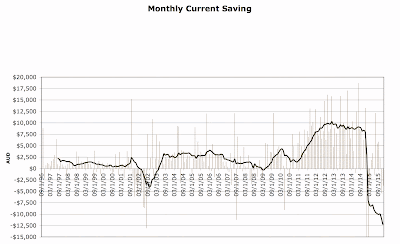 The budget released yesterday actually turned out pretty well for me despite some of the leaked stories. In the end the income level at which the 30% superannuation contributions tax start was lowered from $300,000 to $250,000 rather than $180,000 and the cap on concessional (pre-tax) contributions for people over 50 will stay at $35,000 per year. The cap for under 50s is reduced from $30k to $25k. The biggest changes are a lifetime cap on non-concessional (post-tax) contributions of $500k rather than $180k per year. I might just contribute $500k just before retiring, but it's not going to change my plans. Also there is a $1.6 million cap on how much you can transfer into a tax free account after you retire from an accumulation fund. This number seems to be designed to be equal to roughly the maximum contributions allowed under the new rules over a lifetime. Effectively earnings in retirement on earnings in the accumulation phase above the rate of inflation would be taxed.... Currently, I have $385k in Australian super. If I work to age 65 and continue my current rate of contribution I would add $450k in concessional contributions. So, I could certainly add the $500k just before retiring, as long as investment returns are not too spectacular in the interim.
The budget released yesterday actually turned out pretty well for me despite some of the leaked stories. In the end the income level at which the 30% superannuation contributions tax start was lowered from $300,000 to $250,000 rather than $180,000 and the cap on concessional (pre-tax) contributions for people over 50 will stay at $35,000 per year. The cap for under 50s is reduced from $30k to $25k. The biggest changes are a lifetime cap on non-concessional (post-tax) contributions of $500k rather than $180k per year. I might just contribute $500k just before retiring, but it's not going to change my plans. Also there is a $1.6 million cap on how much you can transfer into a tax free account after you retire from an accumulation fund. This number seems to be designed to be equal to roughly the maximum contributions allowed under the new rules over a lifetime. Effectively earnings in retirement on earnings in the accumulation phase above the rate of inflation would be taxed.... Currently, I have $385k in Australian super. If I work to age 65 and continue my current rate of contribution I would add $450k in concessional contributions. So, I could certainly add the $500k just before retiring, as long as investment returns are not too spectacular in the interim.Other news in the budget is that the 37% tax bracket threshold will be raised to $87k p.a. instead of $80k. That would reduced my tax by $315. So, all in all, it was an OK budget.
P.S.
Now I just read that the concessional cap has been lowered to $25k for everyone, regardless of age. So, what I read yesterday was wrong. But this is from 1 July 2017. So, in the next tax year I can keep my current contributions rate and then after that I will have to cut them and I will have a $3,000 tax hike. Of course, if Labor come to power at the election on 2 July this year that might not happen...
There are a lot of changes, which mostly make super more complicated.









